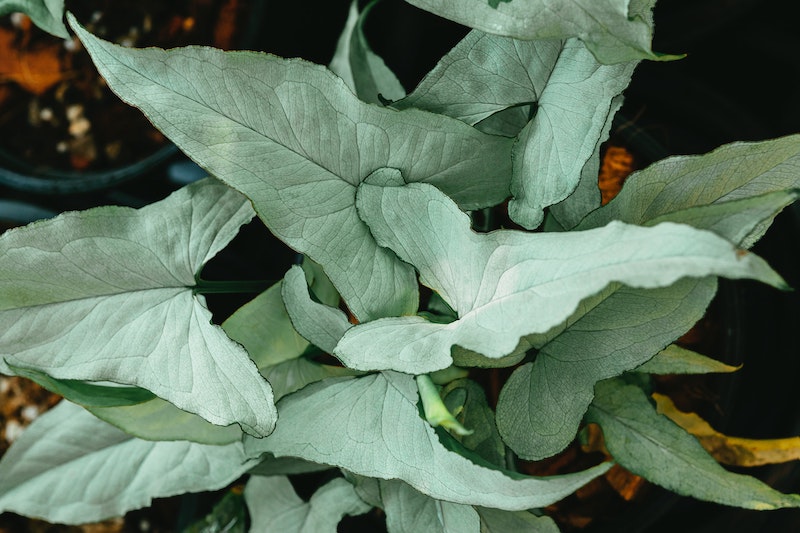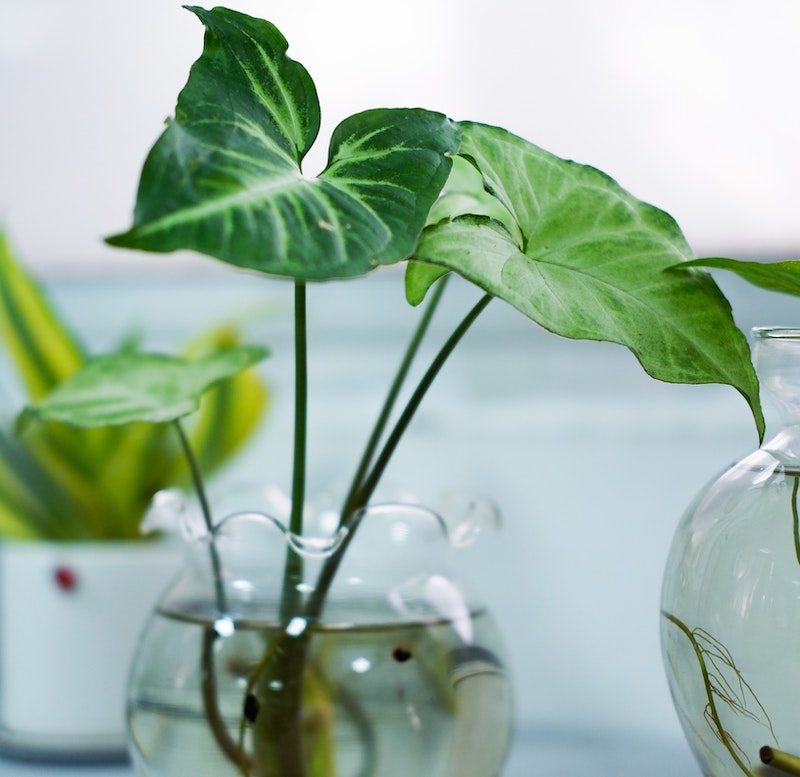Growing Arrowhead Plants
Arrowhead plants are vines native to tropical areas, so they are well suited to bring a lush, low-maintenance flair to interiors in colder regions. This plant, known scientifically as Syngonium podophyllum, offers a shrubby form when young but ages to develop a vining habit. Arrowheads have a moderate growth rate in most home environments and are suitable for beginner growers. Left unchecked in warm areas, it can grow to have a significant length but is typically pruned back as a houseplant in order to retain the most interesting leaf form. Arrowhead plants have a bushier form when kept in check, but can trail or climb over 6 feet if left unpruned.

Arrowhead Plant Sunlight Requirements
In its native environment, the arrowhead plant grows as a vine that uses aerial roots to attach to trees and receives filtered sunlight. As a houseplant, this translates to a preference for bright indirect light. Arrowheads can tolerate low light but the plant will grow slowly and develop a leggy appearance. Direct sunlight can bleach or burn the plant, leaving dry brown spots on the leaves. A windowsill of a north-facing window might be an ideal spot, or try a wall opposite a south-facing window. Cultivars with colorful foliage will achieve their best coloration in bright indirect light and will have less color under lower light.
Planting Arrowhead Plants
Arrowhead plants are not particularly picky regarding soil type, but they require excellent drainage. Use high-quality potting soil with equal parts of peat, perlite, and well-rotted compost. Another option is to use a larger ratio of perlite or even to use a blend that is mostly orchid bark. Arrowhead can be planted to trail or to climb. This plant also grows well when planted with a moss stick or trellis that allows the stems to crawl upward. They naturally send out aerial roots, so after a grower helps guide the plant towards the structure, it will take hold and climb. Repotting every two years or so in spring as the plant’s roots fill its current container will encourage continued growth.

Watering Arrowhead Plants
Arrowheads prefer evenly moist soil. Whenever the top inch of soil feels dry to the touch, water deeply, so that excess water begins to drain out of holes in the container. When growth slows in fall and winter, the arrowhead plant requires much less frequent watering. If an arrowhead is underwatered, leaves will wilt and eventually turn brown. A plant that is wilting from lack of water will perk up quickly following irrigation. Arrowhead plants prefer high humidity but can tolerate average humidity. To increase humidity around the plant, consider using a humidifier or situating the arrowhead on a humidity tray. A lack of humidity will typically cause leaf tips to turn brown.
Fertilizing Arrowhead Plant
Fertilize the arrowhead plant regularly throughout the growing season to encourage vigorous, healthy growth. Use a balanced, fast-release liquid fertilizer or one labeled for foliage houseplants and dilute to half strength. Apply this fertilizer about once per month. If a plant is wilting from lack of water, water it one day and then apply fertilizer a day or two later just as the soil begins to dry down. Alternatively, apply a granular, slow-release fertilizer once in spring when new growth begins to emerge and again in mid-summer. Cease fertilizing during the winter when the plant growth rate slows significantly, and only fertilize plants that are not water-stressed.
Common Arrowhead Plant Problems
Arrowhead plants are generally considered quite easy to grow, but occasionally problems may arise. Small changes in the environment or care routine will often correct issues. Leaves can turn yellow as a result of overwatering, excessive sunlight, or improper fertilizing. Brown leaf tips and margins typically appear due to low humidity or excessive light. If the plant is getting larger and falling over, it either requires pruning back or a support to grow up. Occasional pests of arrowhead plants include mealybugs, aphids, thrips, scales, whitefly, and spider mites. Regular inspection of leaves (and leaf undersides) will allow a grower to catch and address these pests quickly.

Propagating Arrowhead Plants
Arrowhead plants are propagated by dividing the root mass or by using stem cuttings. For stem cuttings, use a sharp cutting tool to remove a section of stem with at least one leaf node, and then place the cutting in a small container with water or directly into well-drained soil. Once roots are about 2 inches long, the new plant is ready for transplant into a more permanent home. Stem cuttings will even root in water and can stay in water for an extended time after roots begin to emerge. Algae growth may occur if water is not changed and eventually the plant in water will need a supplemental liquid fertilization.
Growing Arrowhead Plants Outdoors
Arrowhead plants prefer temperatures between 60 and 75 degrees, so do not bring the plant outside if temperatures are expected to drop significantly below this range. A shady patio area or the dappled shade under a tree are two options where an arrowhead plant might thrive outdoors. It can even be combined with shade-loving annuals in a large planter annually and lifted to bring back indoors each fall. Plants kept outdoors will often dry out faster and require more frequent watering, so check on this plant frequently. Before bringing the arrowhead plant in as weather cools, perform a thorough inspection of leaves and leaf axils in order to spot and address any hitchhiking pests.
 |
Author Angela Ryczkowski - Published 2-25-2023 |
